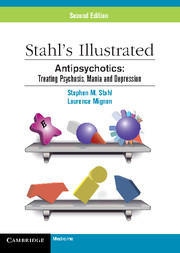Book contents
- Frontmatter
- Preface
- Contents
- CME Information
- Objectives
- Chapter 1 Neurobiology of Schizophrenia and Mood Disorders
- Chapter 2 Multifunctionality of Antipsychotics
- Chapter 3 Side Effects of Antipsychotics: Metabolic Issues and Sedation
- Chapter 4 Individual Antipsychotic Drugs
- Chapter 5 Schizophrenia Pharmacy and Switching Strategies
- Summary
- Abbreviations and Symbols
- Suggested Reading
- Index
- Continuing Medical Education Posttest
- Activity Evaluation
Chapter 1 - Neurobiology of Schizophrenia and Mood Disorders
Published online by Cambridge University Press: 19 October 2021
- Frontmatter
- Preface
- Contents
- CME Information
- Objectives
- Chapter 1 Neurobiology of Schizophrenia and Mood Disorders
- Chapter 2 Multifunctionality of Antipsychotics
- Chapter 3 Side Effects of Antipsychotics: Metabolic Issues and Sedation
- Chapter 4 Individual Antipsychotic Drugs
- Chapter 5 Schizophrenia Pharmacy and Switching Strategies
- Summary
- Abbreviations and Symbols
- Suggested Reading
- Index
- Continuing Medical Education Posttest
- Activity Evaluation
Summary
This chapter introduces the neurobiology that is thought to underlie the symptoms of schizophrenia. The dopamine hypothesis of schizophrenia has been accepted for a long time, especially as the first antipsychotics were shown to block dopamine D2 receptors. This theory posits that dopamine is overactive in some brain areas, and underactive in other brain areas. This chapter shows that it might be more accurate to say that dopamine is neither “too high” nor “too low” but “out of tune.” In addition, ideas about the involvement of glutamate and serotonin have gained momentum in the pathophysiology of schizophrenia, and this chapter aims to give an overview of how these three neurotransmitter systems may come together to induce both the positive and negative symptoms of schizophrenia.
As various antipsychotics have been used in the treatment of mood disorders, this chapter will also go through the hypothetical neurobiology of disorders, such as mania and depression. Beside dopamine and serotonin, norepinephrine is also one of the main players in mood disorders, and will therefore be discussed here.
This brief neurobiological overview of the neurotransmitter systems impacted by antipsychotics will also aid in understanding the occurrence of side effects of different antipsychotics.
In schizophrenia, the neurotransmitter dopamine (DA) is theoretically dysregulated, and as a result various brain areas are overactive, underactive, or otherwise “out of tune,” resulting in the generation of positive and negative symptoms.
Specifically, it has been hypothesized that hyperactivity of this pathway accounts for the delusions and hallucinations observed in schizophrenia. This hypothesis is known both as the “DA hypothesis of schizophrenia” and perhaps more precisely as the “mesolimbic DA hyperactivity hypothesis of positive symptoms of schizophrenia.”
This DA deficit could result from ongoing degeneration due to glutamate excitotoxicity or from a neurodevelopmental impairment in the glutamatergic system. Loss of motivation and interest, anhedonia, and lack of pleasure as observed in schizophrenia result not only from a malfunctioning mesocortical DA pathway but also from a deficient mesolimbic DA pathway.
Although these two pathways are unaffected in schizophrenia, they do play an intricate part in the development of side effects, as they will not remain untouched by drugs interacting with DA neurons throughout the brain.
- Type
- Chapter
- Information
- Stahl's Illustrated AntipsychoticsTreating Psychosis, Mania and Depression, pp. 1 - 30Publisher: Cambridge University PressPrint publication year: 2010



